Efficient warehouse cooling isn’t just a luxury—it’s a necessity for health, safety, productivity, and product integrity. As global temperatures rise and supply chains grow more complex, warehouses must manage heat loads from machinery, lighting, and dense storage areas. Whether you’re storing perishables, electronics, or managing large human workforces, heat control plays a direct role in your business performance.
In this comprehensive guide, you’ll discover data-backed strategies, expert-recommended systems, and interactive comparisons that help you find the best cooling solutions for your facility.
🧊 Key Benefits of an Effective Warehouse Cooling Strategy
- Employee Health & Productivity
Research shows that workplace temperatures above 80°F (26°C) can reduce worker productivity by up to 15%. Cooling systems reduce fatigue, heat stress, and errors. - Equipment Longevity
Excess heat can damage electronics, forklifts, and automated systems. Controlled environments reduce downtime and maintenance costs. - Product Integrity
Some goods—like food, pharmaceuticals, and chemicals—require specific temperature ranges. Cooling helps meet compliance standards and extends shelf life. - Energy Efficiency
Modern systems are designed with low energy consumption, smart automation, and zoning features to cool only where needed—cutting electricity bills significantly.
🌡️ What Causes Heat Buildup in Warehouses?
| Source of Heat | Description |
|---|---|
| Solar Gain | Heat entering through roofs and walls |
| Machinery & Equipment | Operating forklifts, conveyors, and robotics |
| Human Activity | Body heat from large workforces |
| Inadequate Ventilation | Poor airflow trapping heat inside |
| Lighting Systems | Traditional lighting can significantly raise temps |
🔍 Warehouse Cooling Methods: Expert Comparison Table
| Method | Best For | Cooling Range | Pros | Cons |
|---|---|---|---|---|
| HVLS Fans (High Volume Low Speed) | General air circulation | Up to 10°F drop | Low cost, low energy, easy installation | Does not lower ambient temp significantly |
| Evaporative Coolers (Swamp Coolers) | Dry climates, open spaces | 10–25°F | Energy-efficient, low install cost | Less effective in humid areas |
| Industrial Air Conditioners | Precision cooling, closed spaces | Full temp control | High cooling power, humidity control | High energy usage, higher upfront cost |
| Ventilation & Exhaust Systems | Heat/smoke removal, large warehouses | Variable | Cost-effective, improves air quality | Limited direct cooling |
| Chilled Water Systems | Very large or multi-zone spaces | Full temp control | High performance, suitable for large areas | Complex, expensive to install |
🛠️ Choosing the Right Cooling System: Key Factors to Consider
✅ 1. Warehouse Size and Layout
- Ceiling height impacts airflow. Taller warehouses may benefit more from HVLS fans.
- Zoning is crucial. Cooling only work zones saves energy.
✅ 2. Climate Zone
- Hot & dry areas benefit from evaporative cooling.
- Humid climates require dehumidification plus air conditioning.
✅ 3. Product Sensitivity
- Are you storing perishables, electronics, or sensitive pharmaceuticals?
- Required temperature and humidity thresholds must be met for compliance.
✅ 4. Budget & Energy Goals
- Consider lifecycle costs: install, operate, maintain.
- Look for Energy Star ratings and systems with smart controls.
✅ 5. Workforce Density
- In highly populated warehouse zones, cooling directly improves retention and safety.
🔄 Hybrid Cooling Strategies: Maximize Efficiency
Combining different systems can often deliver superior results.
Example Hybrid System:
- HVLS Fans + Evaporative Cooling
Circulates cool, humidified air effectively over large spaces.
Another Example:
- Zoned Air Conditioning + Ventilation
Keeps sensitive zones cooled while exhausting heat from others.
🧠 Expert Tips from Industrial HVAC Engineers
- Tip 1: Use thermal imaging to detect hotspots in your warehouse.
- Tip 2: Program HVAC systems to run during non-peak hours for energy savings.
- Tip 3: Install reflective roof coatings or insulation to reduce solar gain by up to 70%.
- Tip 4: Maintain a regular cleaning and filter replacement schedule to boost system efficiency.
📊 Real-World Data: Impact of Cooling on Productivity
| Temperature Range | Worker Productivity Impact |
|---|---|
| 68–72°F (20–22°C) | Optimal productivity |
| 73–79°F (23–26°C) | Mild reduction (~5%) |
| 80–89°F (27–32°C) | Moderate reduction (~10–15%) |
| 90°F+ (32°C+) | Severe reduction (20%+) |
According to OSHA, workers exposed to extreme heat without proper cooling may experience heatstroke, cramps, or exhaustion—resulting in health risks and legal compliance issues.
❓ Frequently Asked Questions (FAQs)
Q1: What is the most cost-effective warehouse cooling method?
A: HVLS fans and evaporative coolers are generally the most cost-effective for large, open spaces. Their initial cost is low, and they require less energy to operate.
Q2: How can I reduce warehouse cooling costs?
A: Use zoning to cool only active areas, automate thermostats, improve insulation, and perform regular maintenance. Switching to LED lighting can also lower internal heat output.
Q3: Is air conditioning necessary for every warehouse?
A: No. Air conditioning is ideal for sensitive products or strict temperature control, but many warehouses operate effectively using ventilation and fans.
Q4: Can smart automation help with warehouse cooling?
A: Absolutely. Smart sensors and IoT systems adjust airflow and temperature in real-time, reducing wasted energy and keeping zones within safe limits.
Q5: What temperature should a warehouse be kept at?
A: For general comfort and safety, warehouses should be maintained between 68°F to 75°F (20°C to 24°C), depending on the work performed and local climate.
🔧 Maintenance Checklist for Warehouse Cooling Systems
Use this checklist to ensure your cooling systems stay in top condition:
- Clean filters monthly
- Inspect fans for dust buildup
- Calibrate thermostats every season
- Lubricate motorized components
- Check ductwork for leaks
- Inspect and clean evaporative pads
- Monitor humidity levels weekly
- Replace worn belts and hoses
📐 Design Insights: Optimizing Warehouse Layout for Cooling
- Open Aisles: Promote cross-ventilation
- Zoning Barriers: Isolate high-activity areas
- Light-Colored Roofing: Reflects sunlight, reduces indoor heat
- High-Placement of Fans: Moves warm air out efficiently
- Automated Louvers: Direct airflow to where it’s needed most
📣 Engage With Your Warehouse Team
Involving your staff in cooling strategies improves awareness and compliance:
- Training sessions on heat stress recognition
- Feedback channels for temperature complaints
- Personal cooling PPE for high-exertion zones
- Shift scheduling to avoid peak heat hours
📈 Industry Statistics and Insights
- Over 70% of warehouse managers cite heat management as a top operational challenge in summer months.
- Cooling-related downtimes cost U.S. warehouses an estimated $2.3 billion annually.
- Energy-efficient cooling upgrades can reduce utility bills by 30–45% in large warehouses.
- Warehouse operators investing in smart HVAC systems report a 3x return in productivity and energy savings over 5 years.
📌 Bonus: Quick Tips for Instant Heat Relief
- 🌀 Add portable evaporative coolers near workstations
- 🔄 Reverse ceiling fan directions in summer
- 🧱 Seal gaps and cracks to block hot air infiltration
- 🌤️ Install skylights with UV-protective film
- 🔋 Add backup power for cooling in case of outages

















